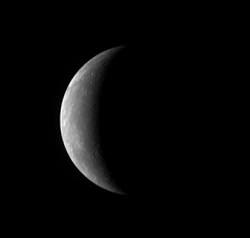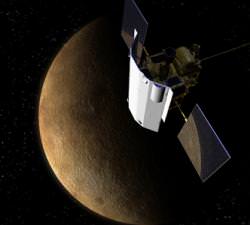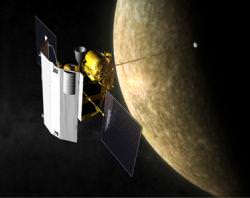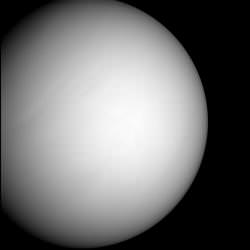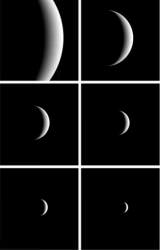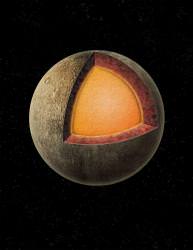On January 14 the MESSENGER spacecraft skimmed just 200 kilometers (124 miles) above the surface of Mercury in the first of three flybys of the planet. Today (Jan. 15) the spacecraft will turn back towards the Earth to start down-linking the on-board stored science data it acquired during the flyby. The probe’s equipment gathered data on the mineral and chemical composition of Mercury’s surface, its magnetic field, its surface topography and its interactions with the solar wind. “This was fantastic,” said Michael Paul, a mission engineer. “We were closer to the surface of Mercury than the International Space Station is to the Earth.”
The closest approach was on the planet’s night side, the side facing away from the sun, and the spacecraft flew in the region along the equator. The scientific results will be available for the public at the end of January.
“The engineers and operators pulled off a tremendous feat, acquiring and locking onto the downlink signal from the spacecraft within seconds, providing the necessary Doppler measurements for the Radio Science team.” said MESSENGER Mission Systems Engineer Eric Finnegan, of the Applied Physics Lab in Laurel, Maryland. “The spacecraft is continuing to collect imagery and other scientific measurements from the planet as we now depart Mercury from the illuminated side, documenting for the first time the previously unseen surface of the planet.”
The signal from the spacecraft is tracked by the Deep Space Network, an international network of antennas that supports space missions.
In addition to Monday’s rendezvous, MESSENGER is scheduled to pass Mercury again this October and in September 2009, using the pull of the planet’s gravity to guide it into position to begin a planned yearlong orbit of the planet in March 2011. By the time the mission is completed, scientists also hope to get answers on why Mercury is so dense, as well as determine its geological history and the structure of its iron-rich core and other issues.
MESSENGER stands for Mercury Surface, Space Environment, Geochemistry and Ranging. Launched in 2004, it already has flown past Venus twice and Earth once on its way to Mercury.
Only one spacecraft has previously visited Mercury. Mariner 10 flew past the planet three times in 1974 and 1975, and mapped about 45 percent of its surface.
With Pluto now considered a dwarf planet, Mercury is the solar system’s smallest planet, with a diameter of 3,032 miles, about a third that of Earth.
A surface feature of great interest to scientists is the Caloris basin, an impact crater about 800 miles in diameter, one of the biggest such craters in our solar system. It likely was caused when an asteroid hit Mercury long ago. Scientists hope to learn about the subsurface of the planet from studying this crater.
True to its name, temperatures on the closest plant to the sun are quite “mercurial,” as Mercury experiences the largest swing in surface temperatures in our solar system. When its surface faces the sun, temperatures hit about 800 degrees Fahrenheit (425 Celsius), but when its faces away from the sun they can plummet to minus-300 Fahrenheit (minus-185 Celsius).
Original News Source: Reuters

